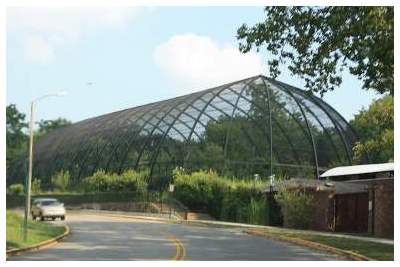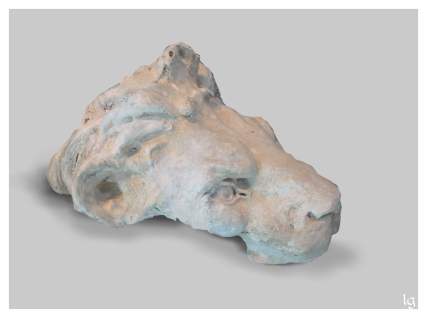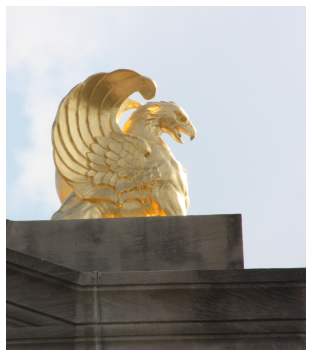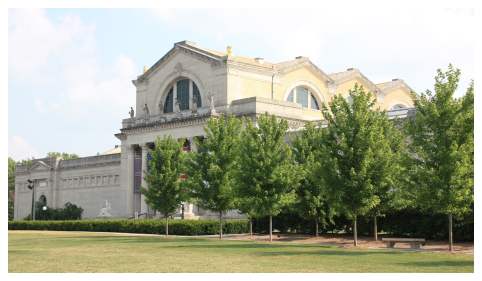Construction-wise, the Palace of Fine Arts was the most unique mega-structure from the 1904 World's Fair, because it was built as a permanent building- from Bedford Limestone instead of wood and staff.
After formally separating from Washington University in 1909, the museum was officially renamed the City Art Museum of Saint Louis, and an organizing board, that was to take control in 1912, was assigned.
An auditorium was added during the 1950's to the main building, creating a venue for films, concerts and lectures.
Money from public associations and individuals has allowed the museum to expand its collections as well as modern-style wings onto its structure. Unbelievably, the museum only has one picture on display that was showed during the Fair.
Guarding the Art Museum, rooftop majestic golden eagles still stand proud for over a hundred years. (2)
Gracing the front of the Art Museum is a bronze copy of "The Apotheosis of St. Louis," the equestrian statue of Louis IX, the city's patron saint. (3)
Originally sculpted by Charles Niehaus, it was made from staff for the 1904 World's Fair and was placed inside the Fair's main entrance. This sculpture to the right was recast in bronze by W. R. Hodges (because Niehaus estimated the cost at 90,000 dollars), for 37,500 dollars for the Louisiana Purchase Exposition Company, which they gave as a gift to the city of St. Louis, on Oct 4, 1906. In 1999, it cost 23,000 dollars to restore.
Near the Art Museum, still stands an original fire hydrant from the World's Fair. In Forest Park, there are a number of these, most of them- painted black. (4)
Looking down from the Art Museum is the renovated `Grand' Basin. It is the centerpiece of a 12.9 million renovation of the area, which included restoring running water through the lakes. (5)
The original Forest Park music pagoda, was a wooden structure that stood on an island in Pagoda Lake. It was dedicated in 1876. Statues adorning the structure represented the four seasons. (6)
During (and after), the 1904 World's Fair, the bandstand was renovated and landscaped for concerts.
Declared unsafe in 1911, before it could be repaired, the structure blew down in a storm.
St. Louis lawyer Nathan Frank donated funds to build a new bandstand, and designed by Heffensteller, Hirsh and Watson, it was dedicated on July 1924 at a cost of 50,000 dollars. Constructed out of marble, the design is a nice nod to the classic Renaissance design of the 1904 Fair.
It was renovated in 1981 at a cost of 13,000 dollars.
The Jefferson Memorial Building, built in 1913, was funded by profits from the Louisiana Purchase Exposition. It cost between 450,000 to 480,000 dollars. It was the first national monument to the country's third President. It is now called the Missouri History Museum. A modern expansion (Emerson Center), was completed in the year 2000. Inside is a large exhibit of 1904 World's Fair artifacts.The 1904 World's Fair exhibit. The second floor is not accessible. The museum is free and worth seeing. (7 & 8)
The Bird Cage is now a part of the St. Louis Zoo, (which is one of the top zoos in the country). During the Fair, people walked through a wire mesh tunnel, now, the structure holds many water fowl, and visitors use a raised boardwalk. See the Flight Cage page for more information. (9)
The majestic statue of our third President- Thomas Jefferson guards the main entrance of the History Museum. Designed by famed sculptor Karl Bitter, the the marble statue was originally commissioned by the Louisiana Purchase Company and was dedicated in 1913. (10)
Part of a staff lion found by a student. The picture was taken through a glass case, and I digitally erased the case/bars and holder. (11)
The World's Fair Pavilion was built after the Louisana Exposition as a part of the Forest Park 1909* restoration. Constructed at a cost of 35,000-40,000 dollars, it was funded by profits from the Fair, as a public shelter and refreshment area. The pavilion is located on Government Hill, where originally the Fair's Missouri Building once stood. (12)
The pavilion was restored in 1980 and totally fixed up in 1998 at a cost of 1,100,000 dollars.
The building can be rented for weddings, and other occasions.
* some say 1910
Francis Field can still be seen in Washington University. It has been modernized and is still in use. The 1904 World's Fair Olympic Games were held there. The gates and plaques were added after the Exposition as a thank you to Fair President- David Rowland Francis. (13 & 14)




